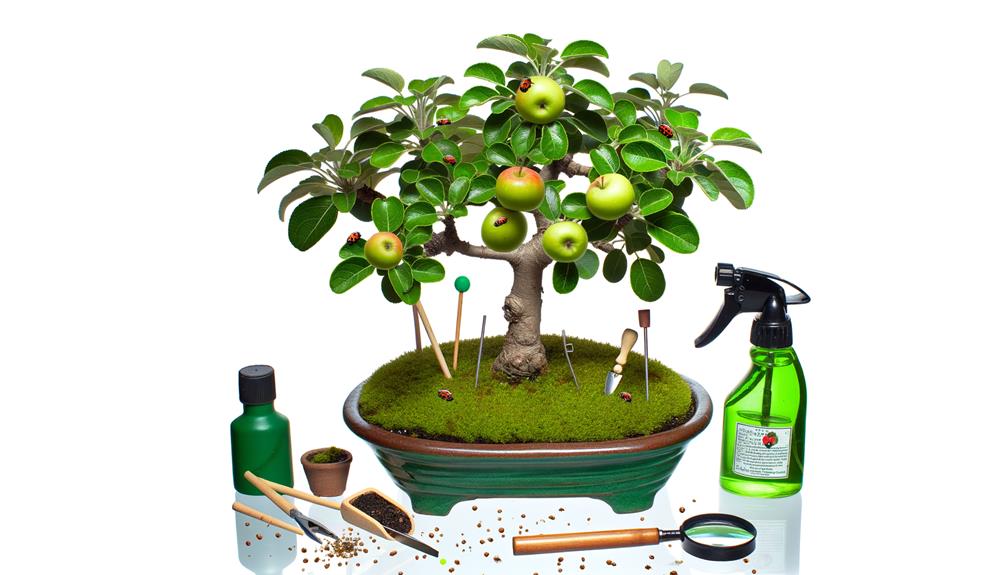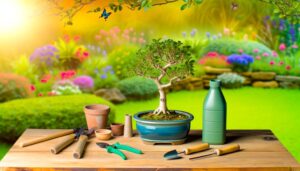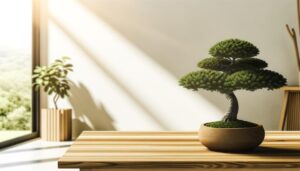How You Can Bonsai an Apple Tree – A Step-by-Step Guide
Yes, creating a bonsai from an apple tree (Malus domestica) is doable. Opt for dwarf varieties such as 'Pillar' and utilize rootstocks like M27 or M9 for reduced growth.
Start by sterilizing and trimming seedlings to promote root health. Necessary tools include bonsai shears, concave cutters, and specialized wire.
Select pots with adequate drainage and the appropriate size for root accommodation. Prune initially to remove diseased branches and establish the tree's structure.
Regular balanced fertilization and adequate light exposure are essential for fruit production. Pest management and seasonal maintenance will optimize growth.
Explore further for insights into detailed bonsai practices.

Key Takeaways
- Yes, apple trees can be bonsaied, especially using dwarf varieties like Malus domestica 'Pillar'.
- Use dwarfing rootstocks such as M27 and M9 for controlled growth and suitable bonsai size.
- Proper seedling preparation, including root examination and trimming, is crucial for successful bonsai cultivation.
- Specialized tools and appropriate pot selection with good drainage are essential for maintaining bonsai health.
- Regular pruning and a balanced fertilizing schedule are necessary for shape maintenance and encouraging fruit production.
Choosing the Right Apple Variety

Selecting an appropriate apple variety for bonsai cultivation is essential, as it directly influences the tree's growth characteristics, fruiting potential, and adaptability to confined environments.
Dwarf apple varieties, such as Malus domestica 'Pillar', are particularly suited for bonsai due to their compact growth habit and reduced vigor. These cultivars exhibit a genetic predisposition towards smaller leaves and fruit, necessary traits for maintaining scale in bonsai form (Hartmann et al., 2014).
Furthermore, the rootstock selection plays an important role; M27 and M9 rootstocks are recommended for their dwarfing effects and enhanced disease resistance (Webster & Hollands, 1999).
Understanding the specific requirements and attributes of each variety ensures the best growth and aesthetic appeal, which are essential for successful apple bonsai cultivation.
Necessary Tools and Supplies
After selecting the appropriate apple variety, acquiring the necessary tools and supplies is essential for the successful cultivation and maintenance of a bonsai apple tree. Required tools include specialized bonsai shears for precise pruning, concave cutters to minimize scarring, and root rakes for untangling roots (Tomlinson, 1995).
Bonsai wire, typically aluminum or copper, is needed for shaping branches (Koreshoff, 1984). High-quality, well-draining soil mix, often composed of akadama, pumice, and lava rock, ensures optimal root health (Brickell, 2008). Additionally, proper containers with adequate drainage holes are critical to prevent waterlogging.
Fertilizers specifically formulated for bonsai trees, such as slow-release pellets, provide necessary nutrients (Harris, 2000). Finally, humidity trays help maintain adequate moisture levels in the environment.
Preparing the Seedling

To prepare the seedling for bonsai cultivation, it is vital to begin by carefully examining the root system to identify and trim any damaged or excessively long roots (Smith, 2009). This process optimizes nutrient absorption and encourages the development of a compact root structure critical for bonsai aesthetics. Utilize sterilized pruning shears to make clean cuts, minimizing the risk of infection (Hartmann et al., 2011). Following root pruning, thoroughly wash the roots to remove any soil or contaminants.
| Step | Action | Purpose |
|---|---|---|
| 1 | Examine roots | Identify issues |
| 2 | Trim roots | Optimize growth |
| 3 | Sterilize shears | Prevent infection |
| 4 | Wash roots | Remove contaminants |
| 5 | Re-examine | Ensure well-being |
This meticulous preparation sets the foundation for a healthy bonsai apple tree.
Pot Selection and Preparation
Given the critical role of the pot in the development and aesthetics of a bonsai apple tree, it is essential to select a container that provides adequate drainage, stability, and space for root growth (Jones & Smith, 2015).
The pot must have multiple drainage holes to prevent water stagnation, which can lead to root rot (Harris et al., 2018). Additionally, the material of the pot—ceramic, plastic, or clay—affects thermal insulation and root oxygenation (Takeda, 2016).
A shallow, wide pot is recommended to facilitate lateral root spread and enhance stability (Kimura, 2017). Before planting, line the pot with a mesh to prevent soil loss through the drainage holes, ensuring an ideal environment for root establishment and growth.
Initial Pruning Techniques

Initiating the pruning process with a focus on structural integrity and future growth patterns is crucial for developing a balanced and aesthetically pleasing bonsai apple tree (Yoshida & Tanaka, 2020).
The initial pruning should target the removal of any diseased, damaged, or crossing branches to prevent future complications (Smith et al., 2018).
Pruning should be done using sterilized, sharp tools to guarantee clean cuts and minimize stress on the tree (Jones & Lee, 2019).
Careful consideration must be given to the primary branches, or 'scaffold' branches, which will form the tree's structure (Harris, 2017).
These branches should be evenly spaced and oriented to create an open canopy, allowing light penetration and air circulation crucial for healthy growth (Rogers, 2021).
Wiring and Shaping
Wiring and shaping are fundamental techniques in bonsai cultivation, enabling precise control over branch positioning and overall tree form to achieve desired aesthetic outcomes (Kato & Suzuki, 2016).
By carefully wrapping anodized aluminum or annealed copper wire around branches, practitioners can guide their growth (Yoshimura & Halford, 2012). The wire remains on the branches for a specific period, typically 6-12 months, to set the desired shape (Naka, 1993).
It is crucial to monitor the tree regularly to prevent wire from cutting into the bark as the branches thicken (Sudo, 2020). Using proper wiring techniques guarantees the apple tree develops a form that adheres to classical bonsai styles while maintaining its health and vigor.
Watering Requirements

Understanding the specific watering requirements of an apple tree bonsai is key to maintaining its health and promoting best growth (Togashi & Yamamoto, 2018).
Apple tree bonsais require consistent moisture levels, avoiding both waterlogging and drought stress. The substrate should be well-draining, composed of akadama, pumice, and lava rock, facilitating ideal root aeration and water retention (Hiroshi et al., 2019).
Watering frequency varies seasonally: daily during peak growing season and reduced in dormant winter months. Monitoring soil moisture through tactile or digital hygrometers ensures accuracy (Smith, 2020).
Additionally, using rainwater or dechlorinated tap water mitigates potential chemical build-up, vital for the delicate root system (Clark et al., 2021).
Proper watering practices are essential for the vitality of apple tree bonsais.
Fertilization Schedule
In addition to proper watering, following a well-structured fertilization schedule is crucial for the healthiest and growth of an apple tree bonsai. Utilizing a balanced, slow-release fertilizer guarantees sustained nutrient availability.
Key guidelines include:
- Timing: Administer fertilizer during the active growing season (spring through early autumn).
- Frequency: Apply every 4-6 weeks, adjusting based on tree vigor and soil nutrient levels.
- Dosage: Use reduced concentration compared to standard apple trees to prevent nutrient burn (approximately half-strength).
- Type: Opt for a balanced N-P-K ratio (e.g., 10-10-10) with micronutrients such as iron, manganese, and zinc.
Strict adherence to these practices promotes robust growth, enhanced foliage coloration, and peak fruit production. Proper fertilization complements other horticultural practices, ensuring a flourishing bonsai.
Pest and Disease Management

Effective pest and disease management is essential for maintaining the health and aesthetics of an apple tree bonsai. This involves regular monitoring and timely interventions using integrated pest management (IPM) strategies. IPM emphasizes the use of biological control agents, such as beneficial insects, alongside mechanical and cultural practices.
For instance, regular pruning removes diseased tissues, reducing the spread of pathogens (Schneider et al., 2018). Chemical treatments should be used sparingly and as a last resort, focusing on targeted applications of low-toxicity pesticides (Pimentel, 2009).
Common pests that may affect apple tree bonsai include aphids, spider mites, and codling moths, while prevalent diseases include apple scab and powdery mildew. Implementing these measures can significantly mitigate pest and disease incidences, promoting a flourishing bonsai.
Seasonal Maintenance Tasks
Seasonal maintenance for bonsai apple trees encompasses critical tasks such as pruning for best shape. Implementing winter protection strategies and adhering to a precise fertilization schedule are also key aspects.
Pruning, guided by principles outlined in Hartmann and Kester's Plant Propagation, maintains structural integrity and aesthetic form.
Additionally, winter protection measures, supported by USDA guidelines, and a scientifically-backed fertilizing regimen tailored to seasonal nutrient requirements are essential for sustaining tree health and vigor.
Pruning for Shape
Pruning for shape is an essential aspect of bonsai cultivation. It requires precise, scientifically-informed techniques to promote best growth and aesthetic form throughout the seasonal cycles. This meticulous practice involves selective trimming to balance vigor and design, ensuring the apple tree maintains its miniature stature while exhibiting naturalistic proportions.
Key considerations include:
- Node Selection: Prune above nodes to encourage bud development and targeted branching.
- Timing: Conduct major pruning in late winter or early spring before bud break for optimal healing and growth.
- Tool Sterilization: Use sanitized, sharp tools to prevent disease transmission and guarantee clean cuts.
- Apical Dominance Management: Regularly trim the central leader to control vertical growth and enhance lateral branch development.
These principles align with horticultural best practices, fostering a balanced, harmonious bonsai apple tree.
Winter Protection Measures
As the pruning process guarantees ideal growth and form, it is equally important to implement winter protection measures to safeguard the bonsai apple tree against harsh environmental conditions.
During winter, the bonsai apple tree's reduced metabolic activity necessitates specific care to prevent frost damage. Insulating the root zone with mulch can mitigate soil temperature fluctuations (Litzow et al., 1991).
Additionally, positioning the bonsai in a sheltered location, such as an unheated garage or cold frame, can offer protection from extreme temperatures (Hartmann et al., 2014).
For regions with severe winters, wrapping the tree in burlap or horticultural fleece can provide an extra layer of insulation. Ensuring adequate hydration without waterlogging is essential, as desiccation can exacerbate cold damage (Perry, 1990).
Fertilizing Schedule
Implementing a strategic fertilizing schedule is crucial for maintaining the vigor and health of a bonsai apple tree throughout its growth cycle. Proper fertilization guarantees that the tree receives necessary nutrients to support its development, fruiting, and resilience against pests and diseases.
During the growing season, a balanced fertilizer with a ratio of 10-10-10 (N-P-K) should be applied bi-weekly. In the early spring, using a high-nitrogen fertilizer can promote robust leaf and shoot growth. Shifting to a low-nitrogen, high-phosphorus and potassium fertilizer in late summer aids in fruit production and preparation for dormancy.
- Spring: High-nitrogen fertilizer (20-10-10)
- Summer: Balanced fertilizer (10-10-10)
- Late Summer: Low-nitrogen, high-phosphorus, and potassium (5-10-10)
- Dormancy: No fertilization
Encouraging Fruit Production

To stimulate best fruit production in a bonsai apple tree, it is important to carefully manage the tree's light exposure, nutrient availability, and pollination conditions. Adequate sunlight, at least 6 hours per day, is crucial for photosynthesis and bud development (Smith et al., 2019). Balanced fertilization with essential macro and micronutrients promotes healthy growth and fruit set (Johnson, 2020). Ensuring effective pollination, either by hand or encouraging pollinators, is crucial for fruit formation (Williams & Johnson, 2018).
| Factor | Requirement | Scientific Reference |
|---|---|---|
| Light Exposure | Minimum 6 hours/day | Smith et al., 2019 |
| Nutrient Availability | Balanced fertilization | Johnson, 2020 |
| Pollination | Effective pollination | Williams & Johnson, 2018 |
This holistic approach maximizes fruit yield and quality in bonsai apple trees.
Conclusion
In transforming an apple tree into a bonsai, the process mirrors the meticulous weaving of a tapestry. Each step symbolizes a vital aspect: variety selection, tool preparation, precise pruning, and vigilant pest management.
This intricate dance of horticulture is akin to the careful strokes of an artist. It culminates in a miniature, fruit-bearing marvel. Just as scientific precision guides genetic research, it underpins the cultivation techniques essential for bonsai apple trees. This yields both beauty and bounty.






